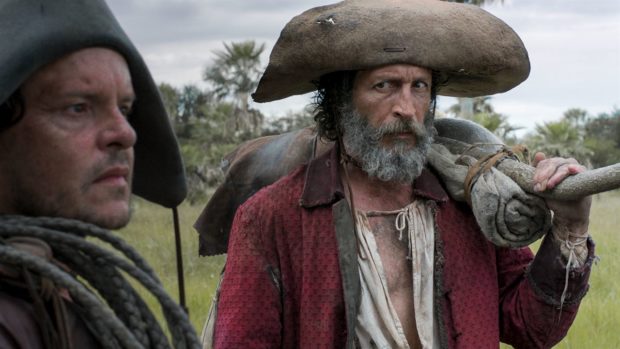 Lucrecia Martel’s latest film is a portrait of colonial futility, in which an 18th century official in an out-of-the-way South American locality struggles to escape, and endure, his plight.
Lucrecia Martel’s latest film is a portrait of colonial futility, in which an 18th century official in an out-of-the-way South American locality struggles to escape, and endure, his plight.
Argentine filmmaker Lucrecia Martel has become my favorite living director. That might sound extravagant to say about someone who has only made four features in sixteen years, but every one of her films has been a powerful and challenging work of art. The latest is called Zama, and for the first time Martel has made a period film, in other words one that doesn’t take place in the present day but in a previous era, and it’s her first adaptation from a book, the 1956 novel of the same name by Antonio de Benedetto.
The film’s title character is Don Diego de Zama, an 18th century colonial magistrate in an out-of-the-way corner of the Spanish empire, somewhere in South America. The native Indians and African slaves serve the white officials and landowners, and daily life is generally dull, hot, and uneventful. Zama has been there too long—his wife and child are across the sea, and he is desperately trying to be transferred away from this backwater so that he can be with them. The governor of the province says that he will send a letter, but first there are bureaucratic obstacles that become more and more difficult as time goes by. Zama tries to seduce a married noblewoman so that she may use her influence. She teases him but does not deliver. The frustration reaches its peak when a new governor arrives and starts treating Zama with contempt.
Zama is played by Daniel Giménez Cacho, and his performance is mesmerizing. His long, careworn face betrays a rigid suppression of despair, a feeling that is nevertheless still evident. As judges go, he is on the lenient side, but his weary sense of entitlement repeatedly catches him up with the peasants and servants he encounters. They either maintain blank obedience or a kind of detached indifference to him. He’s a man who is not quite there anymore.
The filmmaker, Martel, conveys all this in her signature style, with scenes that start in the middle, studied indirection in the editing and camera movement, and an evenness of tone that conveys the sense of being stranded in a meaningless job day after day. It’s difficult to reproduce an historical period convincingly—the film achieves it with seeming effortlessness. The darkness of the makeshift dwellings, the dusty uniforms of the Spanish officials, the ever present horses, mules and llamas blithely coexisting in the same living spaces—all this is beautifully conveyed, and the digital color photography by Rui Porças is absolutely stunning. As in all of Martel’s films, an atmosphere is carefully created, an environment that envelops the audience in its spell. In such an environment, one’s awareness is heightened—awareness of objects, of people in the background, and the unspoken aspects of relationships.
Zama is a man who was born in the New World but still thinks of himself as Spanish. He discovers that others in his class think of him differently. His situation symbolizes the colonial predicament itself, the uprootedness of the colonizer which creates alienation and false consciousness.
One aspect of the story keeps intruding onto the film’s edges, but eventually becomes central. Everyone is afraid of a vicious bandit named Vicuňa Porto. He’s become legendary, but all the colonial officials, including Zama, insist that he’s been captured and executed and there’s nothing to fear. But is it true? The unreliability of supposed facts hangs over the action like an obscuring cloud, just like the main character’s obsession with leaving weighs on his every thought. Zama is a devastating portrait of the futility of conquest.

A hidden gem from 1973 tells of an alcoholic country singer’s much too complicated life. Often in discussions of that brief period in the...

A film from Norway about a young woman seeking fulfillment in relationships takes the conventions of romantic comedy and turns them over to reveal...

One of my favorite movies from recent years was A Separation, an Iranian film about the breaking apart of a family that ended up...